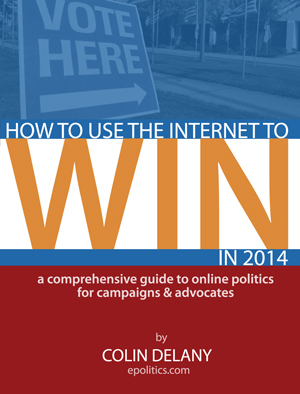The following is an excerpt from “How to Use the Internet to Win in 2014: A Comprehensive Guide to Online Politics for Campaigns & Advocates”, available for download on Amazon.com and here on Epolitics.com. This overview focuses on essential information about Twitter advertising; for a broader discussion of Twitter for politics and advocacy, see the previous exerpt from the Social Media chapter, Political Campaigns on Twitter: Rules, Tools and Essentials.
Also, please note that this excerpt only covers the mechanics of Twitter advertising; the strategies behind why and when to use Twitter ads to achieve particular political and advocacy goals are discussed elsewhere in the book.
Twitter Advertising
Twitter advertising has changed completely in just the past year, giving advertisers much more sophisticated and useful options than they had in 2012. Twitter’s particular strength? As we discussed in the social media chapter, it’s primarily an “opinion leader” medium, meaning that it offers campaigns opportunities to reach people who can shape the public narrative around their race.
The most common Twitter “ads” take the form of “promoted tweets” — tweets that you pay to get in front of more eyeballs than they would reach on their own. Some options:
- Geotargeting by metropolitan area
- Targeting the followers of particular feeds
- Targeting users’ interests or the topics they tweet about
- Targeting OF particular feeds; i.e., serving ads to individual Twitter users through a list you upload — similar to a Facebook custom audience
- Lookalike targeting: reaching people who resemble the people who follow a particular feed or a list you upload, again much like Facebook’s lookalike targeting
- TV targeting: people who engage around particular TV shows (Sunday morning political talk shows, for instance)
Want to get creative? Try targeting political reporters and bloggers in your state to keep your messaging at the top of their feeds every time they go to Twitter. Or, try reaching out their FOLLOWERS, under the assumption that they’re the politically minded folks you need to persuade or recruit. Interest targeting? Likewise, pick the right feeds and hit their followers with the right tweets. Other ideas: GOTV messages to priority audiences, post-debate spin aimed at the chattering class, highlighting a new campaign message…you get the idea.
Besides targeting tweets, you can also pay to promote your feed and grow your following, which may be useful for a campaign trying to grow a base of support fast. Most campaigns will focus on promoted tweets, however, since they both recruit and persuade. As always, your results will depend on the content you choose to promote: a crummy promoted tweet is still a crummy tweet.
Buying Twitter Ads
Promoted tweets and feeds are both very easy to buy; just poke around your Twitter feed and I’ll bet you’ll find an “advertise” button pretty quick (if not, Mr. Google can help you find the right page). The targeting process is actually quite intuitive, more so than Facebook ads at this point — you’ll figure it out right quick if you poke around a bit. Note that both flavors of Twitter ads are typically pay-per click.
For information on the related topic of Facebook outreach for politics and advocacy, see the previous ebook excerpts, “Facebook Content Strategy for Politics & Advocacy” and Facebook Advertising for Politics & Advocacy.


